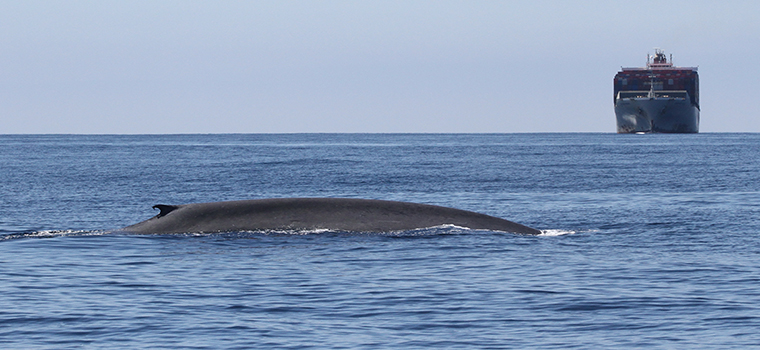It's been a tough couple of months for whales in and around the San Francisco Bay.

A tagged blue whale directly in the path of a ship off southern California (conducted under NMFS Permit 16111 by Cascadia Research). Photo by John Calambokidis, Cascadia Research
BY ZACHARY WARNOW
Published: July, 2018
It’s been a tough couple of months for whales in and around the San Francisco Bay. In just May and June alone, five dead whales washed up on Bay Area shores. While each of these deaths alone is tragic, as part of a larger picture of cetacean deaths they signify a serious threat to the long-term survival of whales.
The good news is that with the right science and the right management decisions, many of these deaths can be prevented. Point Blue Conservation Science, a Petaluma-based nonprofit, has been a leader in recent years in providing recommendations to address these problems.
In California’s waters, the two primary causes of whale deaths are collisions with ships and entanglements with fishing gear. Both problems can be tackled by producing solid science to understand and predict where whales gather in order to recommend practices that decrease the risk from human activities.
The waters off the coasts of San Francisco and Southern California are prime feeding grounds for whales and are also some of the busiest in the world for ship traffic. This is a deadly combination. Ship collisions are the leading cause of death for whales, pushing endangered blue whales toward extinction and threatening the recovery of other species, including humpback and fin whales.
Point Blue research found that more than 80 whales are killed by ships along the West Coast annually, including at least 18 blue, 22 humpback and 43 fin whales. These numbers represent a true emergency for long-lived, slow-breeding whales and the coastal ecosystems and economies that depend upon them.
”Understanding the true number of the ship strike deaths was a key first step to solving this tragic problem,” said Cotton Rockwood, senior marine ecologist with Point Blue. “Now we are working to provide strong science regarding potential regulatory solutions so that managers can take action to decrease the number of collisions and save whales.”
Strategies to reduce whale deaths from ship strikes focus on two approaches. First, Point Blue is working with its partners at the National Oceanic and Atmospheric Administration (NOAA) to evaluate current management measures and recommend new conservation targets. Current management measures include voluntary vessel speed limits, and there is a need to evaluate the extent to which ships have followed these existing recommendations. Second, there is an opportunity to guide science-based policy changes to move vessel traffic away from whale feeding hotspots whenever possible and recommend that ships slow down when passing through feeding areas.
Underpinning both approaches is the need for solid data collection and analysis. Point Blue uses a mix of data from NOAA, the Coast Guard and original data collected on research cruises. But there are key data gaps, particularly in regards to whale behavior and whether they react to avoid possible collision with vessels.
Point Blue partner Cascadia Research studies how whales react to close approaches of ships going at different speeds using tags attached to whales feeding in and around busy shipping lanes. Cascadia also advocates for using cargo ships as platforms of opportunity for conducting research. “Having a biologist on board some of the cargo ships would provide key data from an ideal observation platform that covers the exact routes of greatest interest and also serves to inform ship crews about the risk to whales,” said John Calambokidis, a research biologist and one of the founders of Cascadia.
Looking at the second leading cause of whale deaths—entanglement with stationary fishing gear—Point Blue is collaborating with Blue Ocean Gear to experiment with “smart buoy” technology. These buoys attach to crab pots (one of the main sources of entanglements) and are equipped with GPS sensors that send alerts when a whale has become entangled with the pots. Realtime alerts mean rescuers can quickly take action to save entangled whales. And, at the end of the season, smart buoys can help fishermen recover their fishing pots, saving them time and money. Point Blue is currently helping develop and test this new equipment.
Recently, in June 2018, Point Blue was awarded a grant from the San Francisco-based Battery Club to continue its work to reduce whale deaths in California and beyond. “We’re excited to scale up this work in California and will also be looking further afield for opportunities to bring our research techniques to new geographies,” said Jaime Jahncke of Point Blue.
Zachary Warnow is the director of communications at Point Blue Conservation Science. For more information, visit Point Blue at www.pointblue.org.

